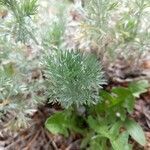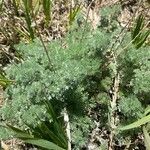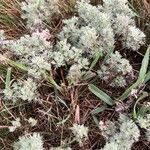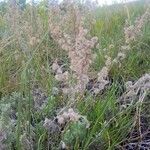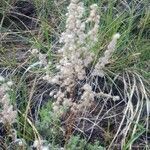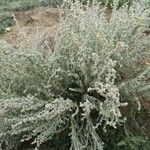Mat-forming perennial 1–4 dm, from a stout caudex or woody crown, somewhat shrubby at base; lvs small and numerous, clustered at base and well distributed along the stem, sericeous-tomentose, the blade 5–12 mm, twice or thrice ternately divided into linear or linear-filiform divisions 1 mm wide or less, commonly with a pair of simple or trifid stipule-like divisions at the base; infl paniculiform, or racemiform in depauperate plants; invol 2–3 mm; receptacle with numerous long hairs; achenes narrowed to the base, truncate above, obscurely if at all nerved; 2n=18. Prairies and dry open places; sw. Wis., Io. and Kans. to Ariz., Alaska, and Siberia, and occasionally intr. eastward. July–Sept.
Perennials, 10–40 cm (forming silvery mats or mounds), strongly aromatic. Stems gray-green or brown, glabrescent. Leaves persistent, silver-gray; blades ovate, 0.5–1.5(–2.5) cm, 1–2-ternately lobed (lobes 0.2–0.5 mm wide), faces densely whitish-pubescent. Heads in (leafy) paniculiform arrays 0.5–2(–4) × 4–15(–20) cm. Involucres globose, (3–)5 × (2–)5–6 mm. Phyllaries gray-green (margins sometimes brownish), densely tomentose. Florets: pistillate 10–17; bisexual 20–50; corollas 1.5–2 mm, glabrous. Cypselae 1–1.5 mm, glabrous. 2n = 18.
A herb. It grows 10-40 cm tall. The leaves are densely woolly. The leaves are finely divided 2 or 3 times. The thin segments are 1 mm wide. The flowers are in yellow nodding heads.
